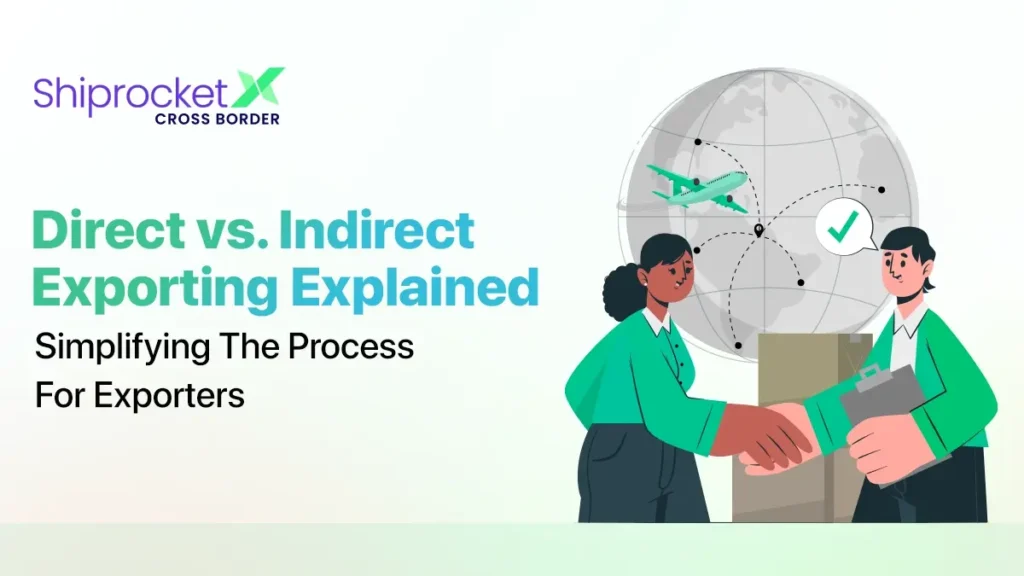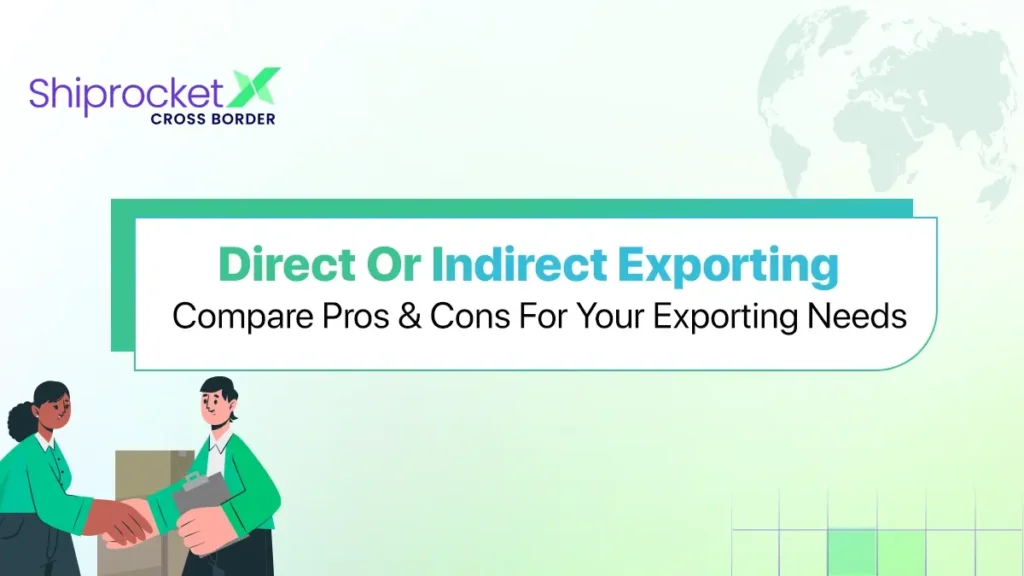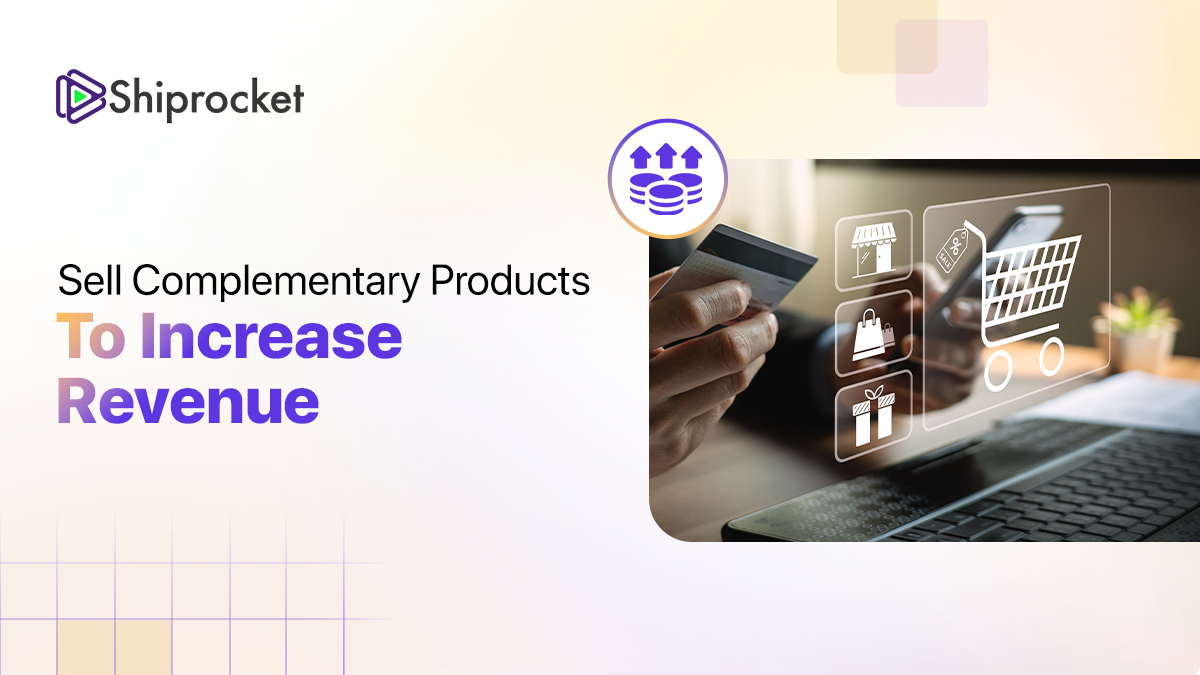Direct vs. Indirect Exporting: Which Path Fits Your Business?
Expanding your brand internationally can be a game changer for your business as it opens doors to new markets and increases profits. But before you jump into international markets, you must choose between direct and indirect exporting.
Both offer distinct benefits and challenges; you must choose one depending on your business requirements, goals, and resources. Direct exporting provides hands-on control while allowing you to interact with customers directly, manage branding, adapt to changes, etc., with a deep understanding of international markets and logistics. However, indirect exporting is like a guide for sellers, providing experienced intermediaries with minimum risks and minimal need for market knowledge.
This blog explores direct and indirect exporting methods and their advantages and disadvantages. Whether you are a hands-on seller who is eager to build customer relationships or want a more streamlined, less risky approach, this blog will help you choose the best exporting method to export internationally.

What is Direct Exporting?
Direct exporting includes selling your products directly to customers in international markets. This means that you, as a seller, do not include any agents, third parties, or trading companies in between. As a seller, you are responsible for finding international buyers, negotiating deals, managing shipments transportation, and handling other aspects of customer service. Direct exporting provides sellers and businesses with a hands-on approach, which further allows sellers to have strong and direct relationships with national or international customers.
Advantages of Direct Exporting
Direct exporting helps you engage and interact with international customers directly and build strong relationships. Some of the other significant advantages of direct exporting include:
- Control over the process: Direct exporting gives you complete control over how your products are presented, advertised, and sold in the international markets. This will allow you to maintain your brand’s image and make appropriate adjustments while catering to different markets.
- Strong customer relationships: Direct exporting will help you build strong relationships with customers, which will also help you understand their needs, collect direct feedback from customers, and customise your brand and its products and services as per customers.
- High-profit margins: You retain your profits as no third party or mediators are involved. This implies that you earn more over each order or sale while increasing your overall revenue.
- Market knowledge: Direct involvement in selling products to customers will keep you informed with market knowledge, consumer preferences, competition, international market needs, etc. This knowledge will help you to make informed decisions and adapt to changes quickly.
Disadvantages of Direct Exporting
While direct exporting is seen as a hands-on approach to reaching international markets and customers, it also comes with multiple disadvantages, such as:
- Increased risk: When you are handling everything yourself, you basically take more risk for your business or your brand, which includes political, legal, and financial risks like exchange rate fluctuations, non-payment for international customers, etc.
- Complex logistics: To manage the international logistics of your business, from shipping to customs, can be complex and tiring. Without the proper knowledge and sources, exporting directly may also lead to delays, compliance issues, and increased prices.
- High efforts and cost: Direct exporting needs proper time, resources, and money, so you will need to manage everything from research to product launch to marketing, selling, shipping, return management, etc. Such tasks can be daunting for you as a seller and may require more effort.
- Needs expert guidance: To succeed in exporting directly, you will need proper guidance and experience in the international market, which includes understanding cultural and legal differences. However, if you have limited or no understanding, experience, or expert guidance of international markets, then you may struggle to succeed.
What is Indirect Exporting?
Indirect exporting is when a brand or business sells its products or services to international markets using intermediaries or third parties like trading companies, export management companies, export agents, institutions, etc. In this process, the middlemen or third parties manage the complex nature of exporting products and services, like handling logistics, dealing with shipping, preparing legal documentation, etc. In indirect exporting, you are basically managing your exporting process with third-party networks and expertise, which helps you succeed and sell your products internationally.
Advantages of Indirect Exporting
Indirect exporting provides a tension-free route to enter international markets, and it comes with multiple other advantages, such as:
- Low risk and investment: Indirect exporting minimises the risks that come while entering international markets. However, because of third parties and middlemen, the process of exporting becomes easier, and the need for investment in market research, logistics, etc., becomes low. The low risk and need for investment make indirect exporting more cost-effective for small and new sellers entering international markets.
- Access to existing networks: Middlemen/intermediaries mainly have established relationships with international customers. Connecting to these networks, you, as a seller, will be able to reach new customers and markets quickly with high and faster sales growth.
- Convenience: You can avoid the complexities of exporting directly by using middlemen who take care of everything. This allows you to focus on the basics of your business, products, and services while the intermediaries manage the exporting.
- Minimal need for market knowledge: The international market needs deep knowledge about consumers, their preferences, needs, cultural differences, legal requirements, etc., but with indirect exporting, your intermediary will minimise the need for you to have deep knowledge as they will majorly handle exporting with their expertise.
Disadvantages of Indirect Exporting
Choosing indirect exporting can provide you with expert guidance, entry into international markets, etc., but it also comes with multiple disadvantages, such as:
- Limited market feedback: As third-party institutions or people will be interacting with the market and consumers, you, as a seller, will not receive consumer feedback, issues, trends, preferences, etc., directly. This lack of insight will make it harder for you to innovate and update your products better to meet the demands of the international market and customers.
- Low-profit margins: Indirect exporting always has low profit margins as intermediaries/third parties take a portion of the profit margin. They charge fees or commissions for their services and expertise, which minimises overall profit and revenue.
- Disparity in interests: It is possible that the third party or intermediary will not have the same interests and priorities as you. You may focus on building long-term relationships with consumers, but they might focus on quick sales. This mismatch in interest does not contribute to sustainable growth.
- Less to no control over sales and marketing: In indirect exporting, you are dependent on middlemen, and you lose your control over the products being marketed and sold. The middleman decides about the marketing, strategies, pricing, branding, etc.

Direct vs. Indirect Exporting: A Side-by-Side Comparison
Here is a side-by-side comparison of direct and indirect exporting:
| Aspects | Direct Exporting | Indirect Exporting |
|---|---|---|
| Market knowledge | It requires a deep understanding of target international markets like customer preferences, market regulations, competition, trends, etc. | It depends on the market knowledge of intermediaries or third parties. There is less need for in-depth market knowledge and research. |
| Risk and responsibility | Sellers are responsible for logistics, currency changes, market changes, and compliance. | Thirds parties assume the risks in exporting and there is less responsibility for logistics and compliance on sellers. |
| Control | There is complete control of sellers on the export process, from manufacturing to marketing to shipping. Sellers create direct relationships with consumers. | There is limited control of sellers as third parties manage the exporting. Minimal to no involvement of sellers with customers. |
| Cost and investments | Involves high initial costs and investments in marketing, distribution, brand building, etc. | Involves low initial cost as a third party manages marketing, distribution, etc. |
| Profit | All the profit is kept by sellers. | A portion of the profit goes to the intermediaries. |
| Long-term growth | Sellers can expect scalability and long-term growth with direct exporting as they prepare for market changes and adaptations. | It is easy to start but has limited scalability. Growth can be achieved by negotiating with intermediaries. |
| Brand and customer relationship | Sellers have direct interaction with customers, which allows them to have strong relationships with them and create a loyal customer base. | Sellers have limited interaction with consumers as third parties promote products. |
When to Choose Direct and Indirect Exporting?
Choosing between direct and indirect exporting while entering international markets can be complex as it depends on multiple factors like market knowledge, growth, sustainability, current abilities, profit, etc. Here are some cases and scenarios through which you can understand when to choose direct and indirect exporting:
When to choose direct exporting:
- If you have deep market knowledge or can invest in market research, then you can choose direct exporting. Understanding rules, regulations, competition, preferences, etc., becomes advantageous for sellers in direct exporting.
- You can choose direct exporting if you have business resources to invest in, like a dedicated team, financial strength, logistics, etc. Sellers will get high returns with such investments.
- If you, as a seller, want to have complete control over your brand image, customer relationships, customisation of marketing strategies, etc., then you should choose direct exporting.
When to choose indirect exporting:
- If you have just started or are unsure about international markets, then indirect exporting can provide you with safe entry points, as third parties here will manage all the complex parts.
- If you want to minimise risk in international exporting, aligning with intermediaries can help share risks and responsibilities.
- If you have limited time, human resources, or money, then indirect exporting can help you succeed without overburdening your sources while managing shipping, marketing, compliance, etc.
Transforming eCommerce Exports with ShiprocketX
ShiprocketX provides a holistic logistics solution that helps sellers streamline eCommerce exports while making it easier for sellers to reach international customers. Some of the features of ShiprocketX that transform your eCommerce export include:
- ShiprocketX ships to over 220 countries, which widens your customer base and offers you multiple international carriers and reliable delivery partners.
- Cost-effective solutions with competitive international shipping rates while providing real-time shipping rates, efficient options, discounted shipping, etc.
- There is an ease to international shipping with ShiprocketX as it handles all the compliance, regulations, and paperwork while reducing the chance of delays or any rejections.
- ShiprocketX offers a customised and real-time tracking experience while improving transparency and customer experience.
- There are multiple shipping options available with ShiprocketX, from express to standard, which caters to customer’s needs and budgets.
Conclusion
The world of international trade includes a crucial choice: direct exporting vs. indirect exporting. Each method has its own set of advantages and disadvantages. Direct exporting allows sellers complete control over the exporting process, from customer interactions to brand management, but it needs investment, time, effort, and risk. Meanwhile, indirect exporting eases the exporting process by using experienced intermediaries or third parties while minimising seller risk and investment, but it also lowers control and profit margins.
If your business is ready to enter international markets with a hands-on approach, then you must choose direct exporting. But, if you want to minimise the risk of entering international markets, then indirect exporting is your solution. Sellers can also partner with ShiprocketX to have comprehensive solutions for logistics, brand building, shipping, etc.
Take the next step confidently while understanding the right strategies and tools to transform your eCommerce exports and succeed in international markets.





